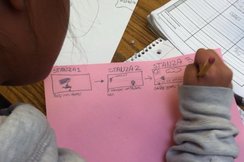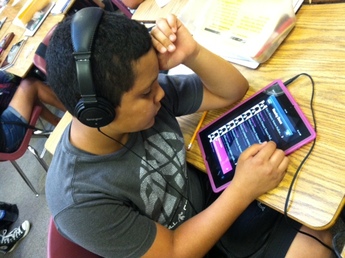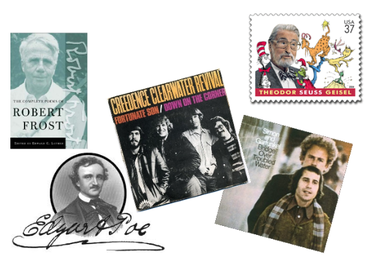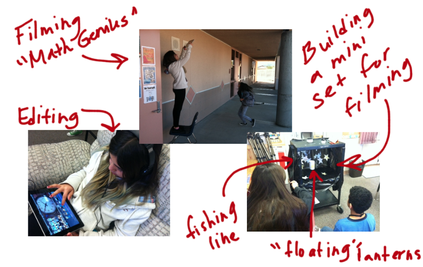 We are a little over a month into the school year here in PSUSD, and I realized today while teaching my morning block of 6th graders that as a class we have finally hit our stride. This is my second year as a BYOD teacher, last year's pilot having been a resounding success. (Thank goodness!) This is also my first year teaching fully Common Core lessons, which has been an easier transition than expected. Since I've been approached quite bit recently, both at my school site and via Twitter, regarding the Common Core lesson planning process, I thought I'd take a moment to blog about it to give others a starting point. Unpack the standard and begin with the end in mind. The first thing I do when planning a CCSS lesson is unpack the standard to decide what skills are expected to reach mastery. There are a lot of fantastic resources on the web that can help you with this step so that you don't have to reinvent the wheel. A few of my favorites are these unpacked "I Can..." statements in student-friendly language and the unpacked ELA Common Core Templates from the Tulare County Office of Education. Use these to help establish your learning targets. Following the unpacking process, consider what the endgame is for students. What will they produce? What will they do to show their learning along the way and once the sequence of lessons is complete? Will they be writing arguments? Engaging in a debate? Recording podcasts? Producing a movie or telling some other kind of digital story? The importance of these questions can not be overstated. Consider the CCSS Shifts, then begin building a series of lessons. There are 7 key shifts in Common Core ELA instruction, which are important to remember. I've outlined these shifts on the following Haiku Deck: When lesson planning, I generally follow the cognitively guided instruction model, which is a gradual release of control until students are able to work independently. Why do I follow this particular model? Because it was adopted universally by my district and that is the expectation. However, something that I have discovered is that, while some feel this instructional model lends itself best to direct instruction, it can also be adapted for inquiry and project-based learning. The concept is, essentially: "I do. We do. You do together. You do independently." The phases of instruction can be rearranged to suit the style of lesson. So, for an inquiry-based lesson, you may choose to lead with the "You Do Together" portion as groups problem solve by brainstorming possible solutions; the "I Do" portion may be limited to simply issuing instructions to express the parameters of the investigation. Create opportunities for communication, collaboration, critical thinking, and creativity. Because my classroom is comprised of so many English Language Learners, providing opportunities for students to work together to communicate their ideas with an authentic audience is important. A few days ago, in the midst of an ELA unit based around the topic of Japanese internment during WWII, my students analyzed primary source photos in groups. I pulled the images from the Library of Congress Japanese internment collection, and had kids rotate through five different centers in groups. Each center had a different image they had to analyze. Students used the Primary Source Analysis Tool (also from the Library of Congress), on which they recorded observations, made reflections, and asked questions about each image. (The suggestions on this document were helpful in terms of getting group conversations started.) Group conversations were dynamic and students were highly engaged because they had previously read and annotated the full text of Executive Order 9066 and Instructions to Japanese-Americans on Bainbridge Island. Following the rotations, students used sentences frames to help them write a podcast about their favorite image from the day and how it connected to their reading. Here is an example podcast one of my students created using the AudioBoo app:
Recognize that the CCSS is student-centered. When I first started teaching, I used to lose my voice by the end of the day because I did so much talking throughout each class period. Nine years later, this is no longer an issue because my students work harder than I do while they are in class. I want to make sure that their learning is genuine, that they are completely engaged in the process, that they have real choices about how to express mastery, and that their brain cells get a workout without realizing that it's "work."
Ultimately, the CCSS transition will be easier for some than others. Districts and school sites will establish different mandates, I am sure. Teachers will likely receive conflicting messages, as is generally true in any kind of new implementation. The best advice I have for anyone who is making the transition is to hold fast to your PLN, ask questions, collaborate, and keep what's good for students at the forefront of your decision-making process. What's your best CCSS lesson planning recommendation? What tools are essential to your CCSS plans? Please comment and share, or continue the conversation on Twitter.
0 Comments
 It never ceases to amaze me just how much good stuff is out there on the Internet, in terms of tech tools that are useful in the classroom. While attending #CUE13, my hands-down favorite session was called "Get SLAMMED with Google" presented by some pretty awesome Google Certified Educators. (Note: On the Educative Gradient of Awesome, these people are off-the-grid wowzers!) They had plenty of useful recommendations, tips, tricks, etc. - but what I really appreciated learning about was a neat little tool called Docs Story Builder. It is such a great find that I went straight back to my classroom the Monday after CUE and put it to work! What is Docs Story Builder? Docs Story Builder is a Google web app that allows users to create conversations in a simulated Google Docs collaborative environment. Check out this silly sample from the Docs Story Builder home page: Tell Me a Story: The Process To implement this brand-new-to-my-classroom tool, I gave my students a quickie tutorial that lasted about a minute, then gave them five minutes to mess around and explore. Because the interface is super easy to use, this was more than sufficient time and generated a lot of excitement. In case you're a fan of how-to videos, here's a brief tutorial, which is actually longer than the prep I gave my students:  Docs Story Builder integrated seamlessly into Language Arts. Students had just finished reading the short story, "What Do Fish Have to Do With Anything?" by Avi. The focus for this reading selection was symbolism, but we also spent quite a bit of time talking about characterization. In the story, a boy named Willie asks his mother difficult questions about life and unhappiness after encountering a homeless man on the street. Students were able to engage in rich discussion because of the complexity of the content. To extend that interaction, I asked students to write a conversation between Willie and his mother, Mrs. Markham. Students had to stay true to the characterization of each as seen in the text, and include a text-based controversial statement made by the character of Mrs. Markham. Here are a few of the Docs Story Builder projects they created:
Reasons Why You Should Heart Docs Story Builder:
Have you used Docs Story Builder in your classroom? I'd love to hear what you asked your students to create - or better yet, see some examples! Comment on this post or hit me up on Twitter (@Packwoman208) to continue the conversation.
Happy Story Building! Middle schoolers have a unique outlook on the world. They are not quite adolescents, yet could not be mistaken for elementary kids either. Capturing their interest and truly engaging them in the learning process can be tricky at best. Sometimes, it seems near impossible. For example, a unique challenge of teaching in the desert of Southern California, is that whenever the weather changes - students inevitably go a little bit crazy. In the land of constant sunshine, a cloudy day, strong winds, or - most shockingly of all - some actual raindrops can bring instruction to a grinding halt. So, when it came time to teach poetry this year and we happened to be smack in the middle of a cloudy and rainy couple of days - I knew I needed to deliver an unforgettable exploration of poetry. Since songs are poetry set to music, I decided to tap into one of my favorites: Starting off by reading In the Ghetto was a good decision. About 80% of the students at my school site come from socio-economically disadvantaged families, and I seem to have a higher than average amount of students this year who are bussed in from a neighborhood known for its gang affiliations. The content of In the Ghetto surprised them - they are used to hearing Elvis' more lighthearted classics play over the loudspeaker at the local water park during the hot summer months. But they were entirely unfamiliar with this song, which quickly and understandably struck a chord. We read the lyrics using the Four Voices strategy. This consists of breaking text into meaningful chunks and color-coding it in four different colors. Each student in a group assumes a color to read and this aids in their overall comprehension of the poetry text. Afterward, I used In the Ghetto as a model text. On clean copies of the poem, we worked as a class to paraphrase each stanza and color-code literary devices. Discussions about tone and mood evolved naturally during the paraphrasing process, and I was delighted to see that engagement was through the roof thanks to the use of Today's Meet. When all was said and done, I played the song so students could hear it. They loved it! To repeat the process, while gradually releasing control until students could execute the read/paraphrase/analyze process on their own, I busted out some other major players in poetry and music. Whenever possible, I shared the songs or You Tube fan tributes in class after reading. (For example, there's a fantastic fan tribute for Annabel Lee on You Tube, which really helped cement understanding for my EL students.)  After our poetry exploration, which included a day of poetry-themed learning centers, I asked students to attempt to write their own poems individually. In groups, students selected their favorites and planned iMovies to illustrate their poems. Since students have previously engaged in digital storytelling, the storyboarding process was very successful at keeping groups on track and focused. The poems were read as voice-overs and some groups chose to add music, while others preferred to deliver their poems slam style. Here are a few of their finished poetry movies: So, what do you get when you combine Elvis, Poe, CCR, Seuss, Simon & Garfunkle, and Frost? Magic for sixth graders learning about poetry!
|
Author: Jessica PackCalifornia Teacher of the Year. CUE Outstanding Educator 2015. DIGICOM Learning Teacher Consultant. 6th Grade Teacher. Passionate about gamification, Minecraft, digital story-telling, and fostering student voices. Download:Archives
June 2020
Categories
All
|






 RSS Feed
RSS Feed